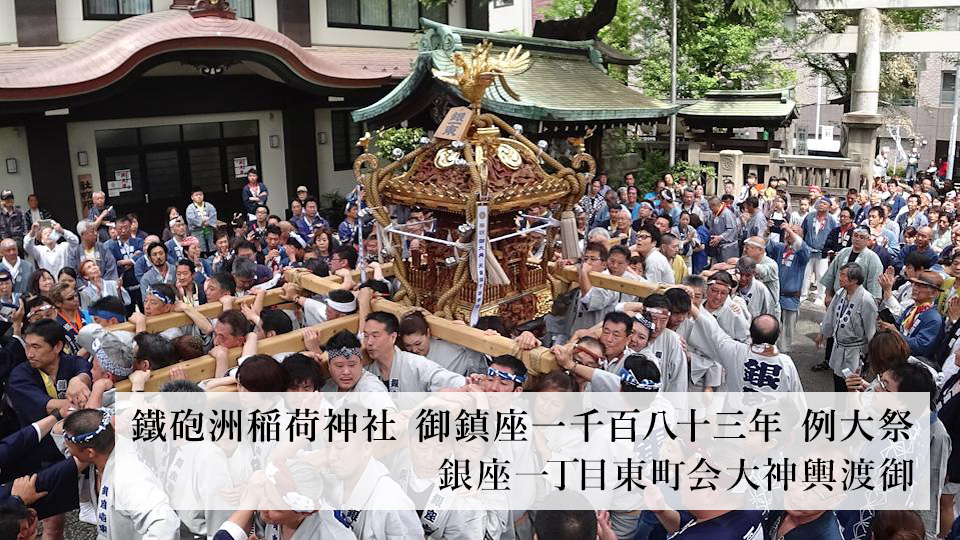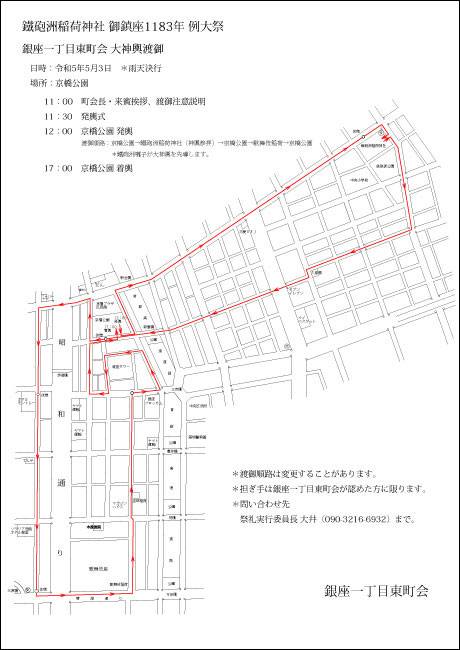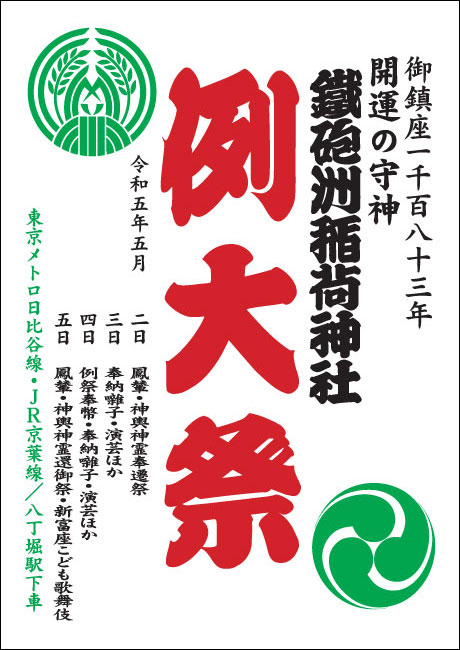
Event Info

Teppozu Inari-jinja Shrine 1,183rd Annual Grand Festival
Ginza 1-chome East Neighborhood Association Grand Mikoshi Procession
The history of Teppozu Inari-jinja Shrine is said to stretch all the way back to the early Heian Period (794-1185) as a shrine founded by the residents of Sakurada Village, located deep in the Hibiya Inlet, to pray for bountiful harvests.
From the end of the Muromachi Period (1336-1573), the shrine was relocated numerous times as the city of Edo developed and land reclamation progressed, having been situated at Shin-Kyobashi (near present-day Ginza 1-12) and Minami-Hatchobori (near present-day Minato 1-8), and has been at its present location (Minato 1-6-7) since 1869.
During the Edo Period (1603-1867), the shrine was revered by sailors as a guardian deity for safe navigation at the entrance to the Port of Edo, and it continues to be worshipped by residents today as a guardian deity of the Kyobashi area.
The Annual Grand Festival will be held over a four-day period from May 2 to May 5. During “Hon Matsuri”, the main festival held once every three years, 12 portable shrines called “Mikoshi” are carried past the Kabukiza Theatre and other locations. Unfortunately, this year’s festival is the “Kage Matsuri”, or “shadow festival”, so there will not be a procession of the town’s Mikoshi. However, on May 3, the Ginza 1-chome East Neighborhood Association, a neighborhood association of shrine parishioners, will hold a grand Mikoshi procession with more than 350 people carrying the Mikoshi to the shrine and to the Kabukiza Theatre in an effort to bring vibrancy to an area that has been left exhausted by the COVID-19 pandemic.
There will be processions of floats in Minato 1- and 2-chome, Minato 3-chome, and Irifune 2-chome on May 4.
On May 3 and 4, the shrine’s “Kaguraden” (hall for traditional Shinto music and dance) will host a range of entertainment including music, Bugaku court dance, sword dance with poetry recitation, traditional Japanese dance, taiko drumming, and stage performances. After the performances, children are given sweets.
There will also be a Shintomiza Children’s Kabuki performance on May 5.
Ginza 1-chome East Neighborhood Association Grand Mikoshi Procession (12:00 p.m. – 5:00 p.m.)
| May 3 | Kyobashi Park (1-25-2 Ginza, Chuo-ku) |
|---|---|
| 11:00 a.m. – | Greeting from the Neighborhood Association President and guests (Chuo City Mayor Taito Yamamoto and others), explanation of the procession |
| 11:30 a.m. – | Mikoshi Departure Ceremony |
| 12:00 p.m. | Departure Kyobashi Park → Teppozu Inari-jinja Shrine → Kyobashi Park → Kabuki Inari-jinja Shrine → Kyobashi Park |
| 5:00 p.m. | Arrival |
Please contact Teppozu Inari-jinja Shrine (TEL: 03-3551-2647) for more information.
Share a link










